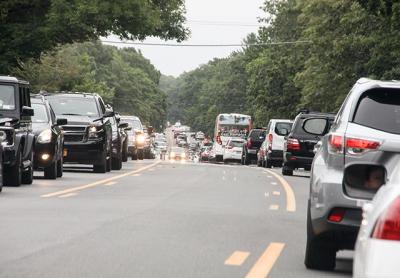Nature Notes: When Will It Stop?

The last big holiday before Election Day has come and gone. Everyone, well, almost everyone, has left the outback and gone back to the suburbs and urbs. We and nature are left to our own devices.
Every year, it seems, the traffic becomes progressively worse. More and more people come to enjoy the East End and more of us native East Enders breathe a sigh of relief and go about our business when the season comes to a close. We have six months to recover, if we ever do.
But the razing and rebuilding is not about to stop completely. Leaf blowers rejoin buzzing saws, commercial traffic continues to rumble past, the autumn calm is but a poor replica of what we grew up with. Yet, notwithstanding all of the open space amassed in the last 20 years, the rumble, although lower in pitch, continues and continues and continues into the winter.
We used to think that when the last McMansion was built on the last empty lot, peace would fall upon us, but that is not the case. A brand-new house is now replacing every older one. Not only does the beat go on, it beats faster and faster with each passing year. It is no longer a surprise that the number-one way of making a living here is by selling and renting real estate. National and international firms have replaced local ones. Is there a successful realtor left in town who is not beholden to one?
At a public forum on offshore wind turbines held in Amagansett two weeks ago, a graph popped up on the screen that showed future energy needs of the area. It started with 2017 and steeply rose into the middle of the century. If my interpretation is correct, it predicted a tenfold increase in energy needs. “How could that be?” I thought to myself. I thought that we were already approaching build-out and headed toward octupling our growth? That chart, which still blazes in my head in two dimensions, strongly suggests such a future.
There are only a handful of dividable parcels left to develop, maybe, fewer than 100 vacant lots in East Hampton, yet that graph raised the question of how many teardowns and rebuilds are in order.
For the past 30 years Bonackers and native residents of lesser means have been bailing out, going south and west. If that graph is true, such emigration will eventually become a stampede.
The handwriting is on the wall. The number of realtors in town now outnumbers the number in every other working-class category including plumbers, electricians, carpenters, and the like. When I started working for the town in 1983 there were more than 100 baymen and almost that many offshore fishermen. Why is there a daily “trade parade” on Long Island that begins and ends west of Brookhaven, making traffic unbearable in the morning and afternoon?
The western suburbs are also facing similar growing pains. Not all Long Island tradespeople work on the East End. One learns by reading Newsday every day that there is no end to the number of units approved for Brookhaven, Smithtown, Babylon, Huntington, Hempstead, Oyster Bay, and North Hempstead, not to mention the cities of Glen Cove and Long Beach.
If all of the units before Long Island planning and zoning boards today and those in realtors’ and developers’ heads were approved and built within the next five years, the population (and energy needs) would grow by more than 10 percent. We already have three million or so inhabitants in Nassau and Suffolk Counties. In other words, Long Island outside of Brooklyn and Queens would rank among the top most populous cities in the United States.
About five years ago, Larry Swanson, a professor and chairman of Suffolk County’s Council on Environmental Quality and Chris Gobler, a Stony Brook University professor, co-wrote an op-ed piece in Newsday that advanced very believable arguments supporting the notion that Long Island is already built out.
Since that article, traffic has increased, building has increased, there’s another new shopping mall every year, and public schools are, as ever, bursting at the seams. Our sole-source aquifer is loaded with this and that harmful chemical. Atmospheric ozone figures are among the highest in the state, at least 50 percent of our estuarine and freshwaters are seriously polluted, shellfish populations have disappeared, and on and on and on. And the sea is rising around us more rapidly with each passing year.
People, we are already past the tipping point and well on our way to dystopia! What then? All progress is not good progress! When will it stop?
Larry Penny can be reached via email at [email protected].
